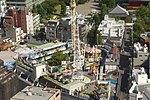Asakusa Station
Art Deco architecture in JapanAsakusaInternal link templates linking to redirectsRailway stations in Japan opened in 1927Railway stations in Tokyo ... and 6 more
Stations of Tobu RailwayStations of Tokyo MetroStations of Tokyo Metropolitan Bureau of TransportationTobu Skytree LineToei Asakusa LineTokyo Metro Ginza Line

Asakusa Station (浅草駅, Asakusa-eki) is a railway station in the Asakusa district of Taitō, Tokyo, Japan, operated by Tobu Railway, Tokyo Metro, and Toei Subway. It formed one terminus of the original subway line in Tokyo, now the Ginza Line.
Excerpt from the Wikipedia article Asakusa Station (License: CC BY-SA 3.0, Authors, Images).Asakusa Station
Sukeroku Yumedori Street, Taito Asakusa
Geographical coordinates (GPS) Address Phone number Website Nearby Places Show on map
Geographical coordinates (GPS)
| Latitude | Longitude |
|---|---|
| N 35.711944444444 ° | E 139.79833333333 ° |
Address
浅草エキミセ (東武浅草駅ビル)
Sukeroku Yumedori Street 1
111-0033 Taito, Asakusa
Japan
Open on Google Maps










